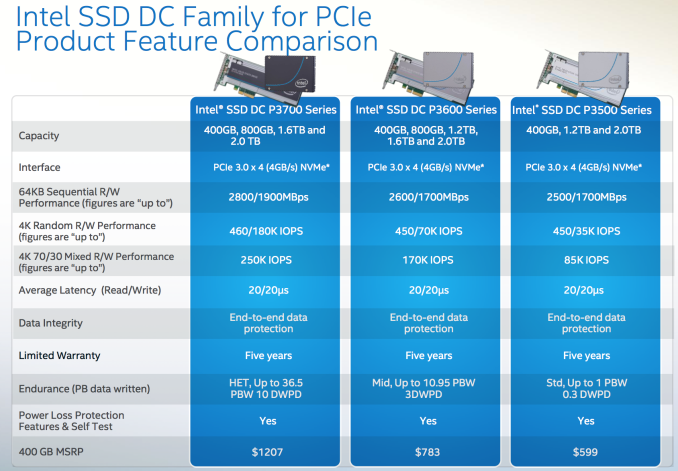The Intel SSD DC P3700 Review Part 2: NVMe on Client Workloads
by Anand Lal Shimpi on June 10, 2014 12:07 AM EST- Posted in
- Storage
- SSDs
- Intel
- Intel SSD DC P3700
- NVMe
Final Words
In the past, high-performance enterprise PCIe drives didn't do all that well in our client test suite. Intel's SSD DC P3700 on the other hand does remarkably well, thanks in no small part to its excellent performance at low queue depths. A continued focus on IO consistency and performance recovery also help tremendously. In our heaviest client workload (our 2013/Destroyer benchmark), the P3700 takes the crown as the fastest SSD we've ever tested.
At $3/GB, the P3700 is a clear fit for enterprise workloads but I can see that being a bit too pricey for even a high end client PC. The real question is how close can Intel's cheaper, lower endurance NVMe drives get to the P3700's performance. The P3500 and P3600 will be available at much lower price points, and may be able to deliver a good portion of the P3700's performance.
Intel won't be shipping the rest of its lineup for a little while longer, but as soon as we get those drives in house we'll provide an update.











36 Comments
View All Comments
alacard - Tuesday, June 10, 2014 - link
Very grateful that you posted this second look. Very interesting results. Now we just NEED a review of Fusion IO's Octal drive and my life will be complete. Make it happen Anand!extide - Tuesday, June 10, 2014 - link
x2 on both! Love this drive though!lukewayne - Tuesday, June 10, 2014 - link
Anand,Great content as usual.
Might want to consider using the same scale on the graphs for each drive, clicking from P3700 to S3700 on the first graph, it was easy to miss the change in scale on the vertical axis. Would be easier to see difference if higher was faster across all drives.
In any event, I do really like this way of showing comparison data. keep up the good work!
nfriedly - Tuesday, June 10, 2014 - link
I was going to say the same thing - my initial impression was that it was about on par with the other drives.brucek2 - Tuesday, June 10, 2014 - link
Same. Especially true when the units are a one with a lot of zeroes but no commas, which makes it easy to mistake say 100,000 for 1,000,000 in the first place. I'd say go wild and go for both consistent scale AND commas!mtoma - Tuesday, June 10, 2014 - link
Is this drive bootable?althaz - Tuesday, June 10, 2014 - link
In OSX and Linux yes, but AFAIK not yet in Windows.hpvd - Tuesday, June 10, 2014 - link
sure no windows booting?maybe one simply have to have the right windows version (8.1 or server) and the right driver...
see
"NVM Express Boot Support added to Windows 8.1 and Windows Server 2012 R2"
http://www.nvmexpress.org/blog/nvm-express-boot-su...
juhatus - Tuesday, June 10, 2014 - link
Quote from link: "Using the Windows inbox driver requires the platform to have the appropriate BIOS support and the device is not an eDrive implementation."So BIOS upgrade should do it atleast? Here's hoping they'll fix BIOS´s
Sunburn74 - Tuesday, June 10, 2014 - link
Being bootable is a big deal and a must have feature